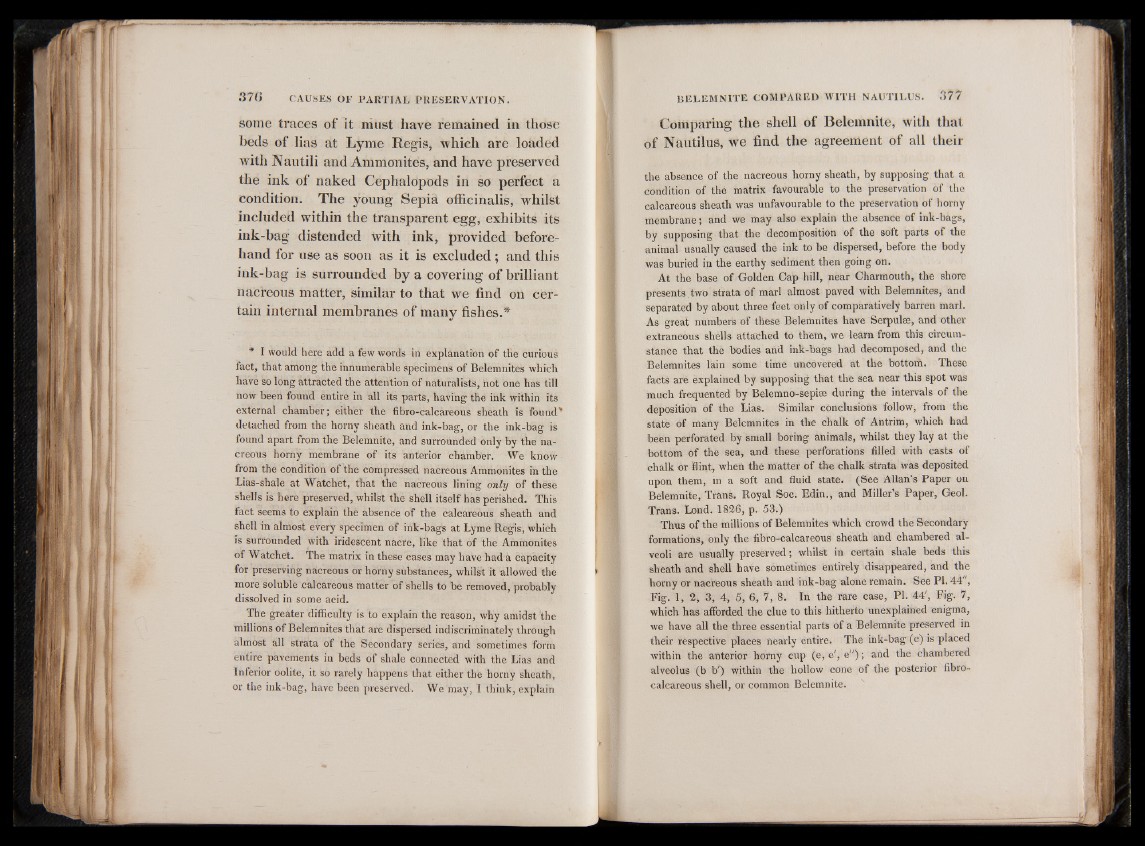
some traces of it must have remained in those
beds of lias at Lyme Regis, which are loaded
with Nautili and Ammonites, and have preserved
the ink of naked Cephalopods in so perfect a
condition. The young Sepia officinalis, whilst
included within the transparent egg, exhibits its
ink-bag distended with ink, provided beforehand
for use as soon as it is excluded; and this
ink-bag is surrounded by a covering of brilliant
nacreous matter, similar to that we find on certain
internal membranes of many fishes.*
* I would here add a few words in explanation of the curious
fact, that among the innumerable specimens of Belemnites which
have so long attracted the attention of naturalists, not one has till
now been found entire in all its parts, having the ink within its
external chamber; either the fibro-calcareous sheath is found'
detached from the horny sheath and ink-bag, or the ink-bag is
found apart from the Belemnite, and surrounded only by the nacreous
horny membrane of its anterior chamber. We know
from the condition of the compressed nacreous Ammonites in the
Lias-shale at Watchet, that the nacreous lining only of these
shells is here preserved, whilst the shell itself has perished. This
fact seems to explain the absence of the calcareous sheath and
shell in almost every specimen of ink-bags at Lyme Regis, which
is surrounded with iridescent nacre, like that of the Ammonites
of Watchet. The matrix in these cases may have had a capacity
for preserving nacreous or horny substances, whilst it allowed the
more soluble calcareous matter of shells to be removed, probably
dissolved in some acid.
The greater difficulty is to explain the reason, why amidst the
millions of Belemnites that are dispersed indiscriminately through
almost all strata of the Secondary series, and sometimes form
entire pavements in beds of shale connected with the Lias and
Inferior oolite, it so rarely happens that either the horny sheath,
or the ink-bag, have been preserved. We may, I think, explain
Comparing the shell of Belemnite, with that
of Nautilus, we find the agreement of all their
the absence of the nacreous horny sheath, by supposing that a
condition of the matrix favourable to the preservation of the
calcareous sheath was unfavourable to the preservation of horny
membrane; and we may also explain the absence of ink-bags,
by supposing that the decomposition of the soft parts of the
animal usually caused the ink to be dispersed, before the body
was buried in the earthy sediment then going on.
At the base of Golden Cap hill, near Charmouth, the shore
presents two strata of marl almost paved with Belemnites, and
separated by about three feet only of comparatively barren marl.
As great numbers of these Belemnites have Serpulee, and other
extraneous shells attached to them, we learn from this circumstance
that the bodies and ink-bags had decomposed, and the
Belemnites lain some time uncovered at the bottom. These
facts are explained by supposing that the sea near this spot was
much frequented by Belemno-sepiee during the intervals of the
deposition of the Lias. Similar conclusions follow, from the
state of many Belemnites in the chalk of Antrim, which had
been perforated by small boring animals, whilst they lay at the
bottom of the sea, and these perforations filled with casts of
chalk or Hint, when the matter of the chalk strata was deposited
upon them, in a soft and fluid state. (See Allan’s Paper on
Belemnite, Trans. Royal Soc. Edin., and Miller’s Paper, Geol.
Trans. Lond. 1826, p. 53.)
Thus of the millions of Belemnites which crowd the Secondary
formations, only the fibro-calcareous sheath and chambered alveoli
are usually preserved; whilst in certain shale beds this
sheath and shell have sometimes entirely disappeared, and the
horny or nacreous sheath and ink-bag alone remain. See PI. 44",
Fig. 1, 2, 3, 4, 5, 6, 7, 8. In the rare case, PI. 44', Fig. 7,
which has afforded the clue to this hitherto unexplained enigma,
we have all the three essential parts of a Belemnite preserved in
their respective places nearly entire. The ink-bag (c) is placed
within the anterior horny cup (e, e', e"); and the chambered
alveolus (b b') within the hollow cone of the posterior fibro-
calcareous shell, or common Belemnite.